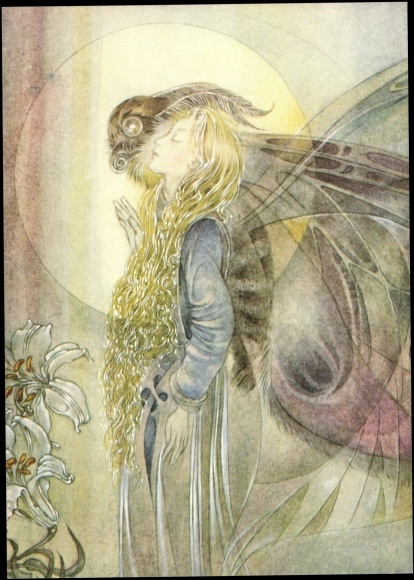La Papillon de Nuit
So what ties the moth to the vampyre?
First, we must see if there is evidence that does. So far, I have found that my great-grandfather’s last name is tied to moths. And then there is the 1922 work by Henri Gerbault, ‘Le papillon de nuit.’ Note that the moth markings in the garment end in the crescents found on the Milleria Moth.

It is not difficult to see the leap from lady vampyres calling themselves or being called, “vamps” as a descriptive term while inspiring fashionable society and their human imitators calling themselves the same thing.
Unfortunately, the human behavior would then have associated the actual vampyre term “ladies of the night” with prostitution. This is not to say that there is something wrong with sex work but it is not the vampyre way. Though there are a number of vampyres involved in those industries as owners and handlers.
The word, “polilla” means “moth” in zoology but it also means “prostitute” in Peru. This is a change from the term and symbol of a butterfly being historically associated with prostitutes. So here too we likely have the symbol for Eve being swapped interchangeably for that of Lilith.
Here also we have the names “Maria” and “Mari.” What is the significance of pose? Was Maria/Mari that statue once brought to life? Is she posing as Lilith? The etymology of words provides the clues.
A European word for moth, Traça, is also interesting because some of the definitions deal with destruction. While possibly tied to the clothes moths and the havoc they wreak on wool, it also connects to the terms of destruction associated with many of Eve’s monikers or aliases, as well as her enjoying pretending to be a wolf or rather, a wolf in sheep’s clothing).
And in this, we also see the interconnectedness of “fairy.” Moths and butterflies were often confused as being fairies but there is likely origin of the vampyre in being fairies and not in being elves as the two concepts were not historically interchangeable. Also that homosexuals were called “fairies” would lead me to believe this is because male vampyre were roaming the streets at night and choosing other male victims. Perhaps this was due to sexual preference, out of chivalry. the ability of a male to withstand the attack, or needing higher numbers of strong males in the vampyre population.
The artist Sulamith Wülfing also clearly saw the symbolic connection between moths and angelic or fairy beings.


As an anagram, Mariposa points to the Páramos Andean moutain range as being a likely source of a great deal of origin information. This is fitting since the Milleria moth is found mainly in China and SE Asia, but the Milleria plant is from Southern Mexico (Yucatan), Central America and the northern parts of South America. My great-grandfather was leaving a clue on the direction to follow when he named his dog, “Daisy.”
Another clue might be in the former nickname of my father’s half-sister, Caroline. She is daughter of Charles (Chuck) Anstedt and of true Anstedt blood, as far as I know. My father took on the last name when Chuck married his mother, Elise. When younger, Caroline was given the nickname, “Cookie.”

In Pinoy, Cocol is slang for coffee.


